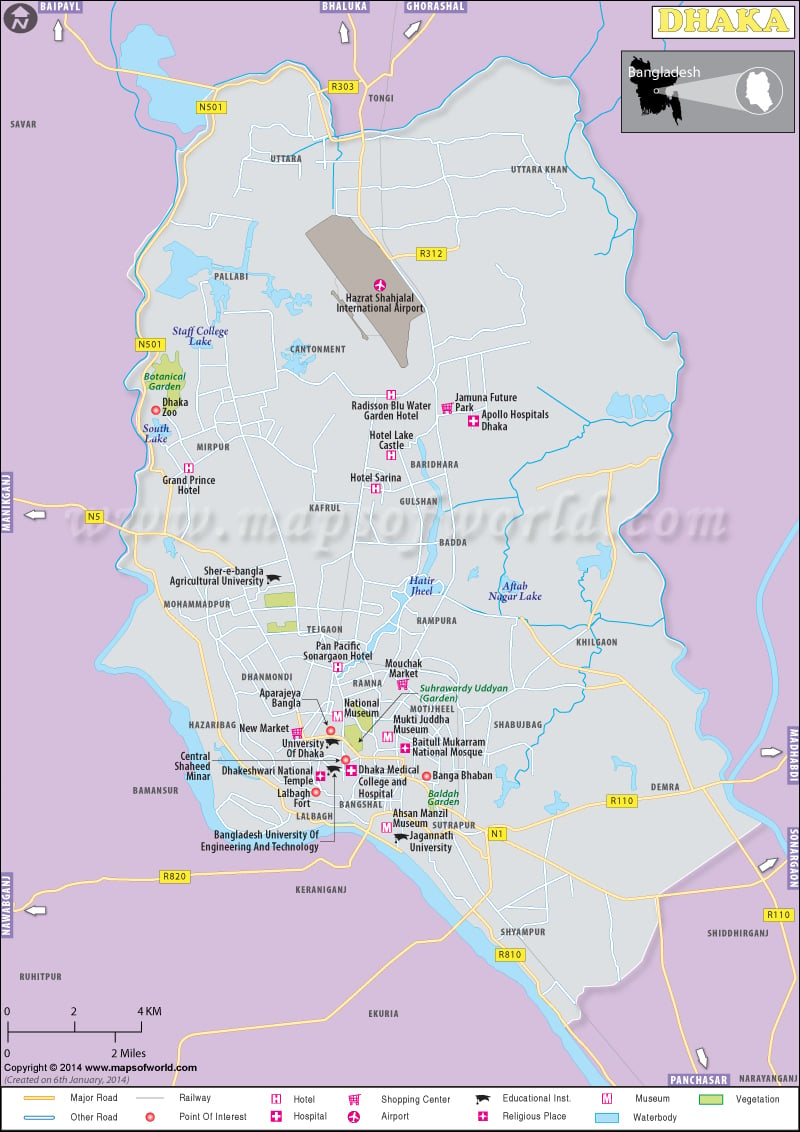Dhaka is the capital of Bangladesh and serves as the financial, political, cultural, and scientific center of the country. The largest city in Bangladesh, and one of the largest in the world, Dhaka is also one of the most densely populated.
Because of its growing popularity among foreign investors and tourists, the city is also considered as one of the fastest growing metropolis in the world.
Geography
Dhaka is located in the heart of Bangladesh, along the river Buriganga. It is relatively flat and low-lying, making it prone to flooding and susceptible to many storms and natural disasters.
How To Reach (Modes of Transportation)
By Plane – The Hazrat Shahjalal International Airport is the primary airport that serves the city. It currently offers 18 international destinations such as London and Rome but schedules are subject to occasional change.
By Rail – The Maitree Express directly connects Dhaka to Calcutta, India. It is the only international railway in Bangladesh, and is rarely used with only about 50% of the cars occupied in every voyage. It is, however, a faster and more convenient mode of transportation than buses. There are no current metro rail systems in the city.
By Bus – Dhaka is the national hub for bus companies in the country, with open-window buses circulating the main roads and city center. Luxury buses are also offered for long-distance routes.
By Boat – The Sadarghat of Old Dhaka is the main port that serves boat rides along the Burigangu River.
By Taxi – Several taxi companies can be found in the city centre but they’re hard to get in the busy roads. Pre-booking a taxi that will pick you up is the best option.
Cycle Rickshaw – Dhaka is the rickshaw capital of the world, with hundreds of thousands of them littering the streets and main roads – contributing to the city’s difficult traffic. They are usually used on smaller streets and for short distances. CNG’s or auto rickshaws, named after the fuel it uses called compressed natural gas, are used for longer distances and for main roads.
When to Visit
Dhaka has a hot and humid weather, with monsoon seasons. The hottest months are from late March to early June, making it the best time to visit the city for convenient sightseeing. The colder month and less humid season is December, which is a favorite month for many tourists coming from colder climates. The months of June to September comprise the rainy season and touring the city in wet grounds is highly inconvenient.
Culture (Fairs and Festivals) and Traditions
Durga Puja – Bangladesh has the 2nd largest Hindu population in the world, and this festival is the city’s annual celebration and worship of the goddess Durga. This religious festival is celebrated for 6 days and is the biggest one in the city – expect to have colorful and vibrant celebrations in the mosques and many houses of Hindu worship.
Pohela Baishakh – The Bengali New Year celebration that occurs in April 14 of every year, large crowds of people occupy the streets with celebrations of grandeur and colors. Performances, games, traditional sports, and exhibitions of Bengali culture abound in the city.
Ekushey Book Fair – For the whole month of February, Dhaka holds a festive book fair that has evolved from a humble event to a yearly festival that involves cultural and literary events. Books are offered with 25% discount and people from allover the country flock to stroll the stalls and to engage in the festivities.
Points of Interest (Places to Visit)
Ahsan Manzil – The famous pink palace of Dhaka, it is the perfect example of how the people of Bangladesh lived in luxury many years ago. The former official residential palace of the Dhaka royal family, it is now the Bangladesh National Museum and considered as one of the most significant architectural structures in the country.
Lalbagh Fort – An incomplete palace that was built in the 17th century, it is a beautiful complex that contains a tomb, a mosque, a museum, and an audience hall.
Star Mosque – one of the most popular attractions in Dhaka, its structure is made of white marble that are decorated with blue star tiles that fill the entire dome. Visitors are allowed to enter after prayer but are still expected to follow rules of dress and conduct.
Accommodation
There is very little tourist infrastructure in Dhaka, as its tourism industry has only begun to become popular very recently. There are a few hotels in the city center but finding one on a whim may be difficult. It’s best to book accommodation in advance when planning to visit Dhaka.

